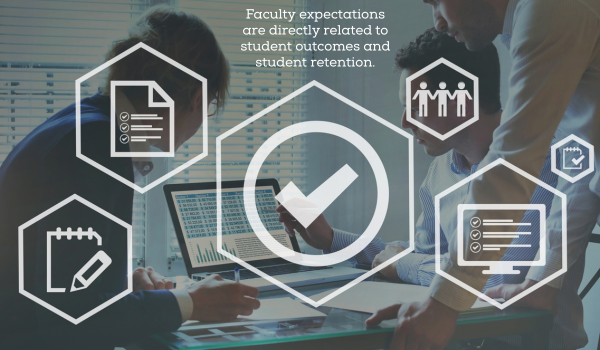What Happens When Faculty Have No Standards to Follow: Student Outcomes Suffer
As online education continues to evolve, two primary models of distance learning have taken root in the United States.
The first is the competency-based model. In this approach, students are not enrolled in courses led by instructors. Instead, they move independently through subject matter by completing tests, quizzes, and written assessments. Once they reach a passing threshold, they continue to the next subject. While this model offers flexibility and self-paced learning, it often lacks structured engagement — and students can miss out on meaningful guidance from a dedicated educator.
The second model — and the one I want to focus on — is the instructor-led online classroom. This is the more traditional format, where students are enrolled in scheduled courses, supported by an instructor, and guided through weekly deadlines. These classes typically include interactive elements such as discussion forums, feedback loops, and ongoing written assignments.
I’ve worked in distance education for over 20 years, with the majority of that time focused on faculty training and program development. Through this experience, I’ve seen the transformative role faculty can play — when they are consistently present, responsive, and engaged. In competency-based models, that human connection is often missing altogether. But even in instructor-led classrooms, the student experience can vary dramatically depending on whether instructors are held to any consistent standards at all.
Some institutions provide clear, firm expectations for faculty. Others rely on vague language — or offer no structure at all. And when there’s no structure, students feel it. They notice when instructors are slow to respond, absent from discussions, or disconnected from the course altogether. Most students won’t file a complaint. But the consequences accumulate — in the quality of student work, in retention rates, and in the long-term credibility of the program itself.
Below, I’m sharing a framework I’ve used to shape faculty expectations — one that supports both instructor performance and student success. If your institution lacks clear standards, this may be a valuable place to start.
Explaining Conditions Observed in Online Classes
What I will first share are observations of online classroom conditions, from my work in faculty and curriculum development, when faculty standards have been put in place — along with observations of conditions of online classrooms when there are no formal faculty standards.
When Faculty Standards Have Been Put in Place
When clear, consistent faculty standards are in place, the difference is unmistakable — both in how the course operates and in how students respond.
These are the classrooms where end-of-course evaluations reflect the highest scores, particularly in areas related to structure and instructor engagement. Faculty understand that their work is subject to observation at any time by Academic Affairs or other leadership, and they know regular reviews are part of their role. Teaching assignments are closely tied to accountability — instructors who meet expectations continue to be invited back because they consistently uphold those standards.
Inside the classroom, the difference is visible:
- Faculty establish a strong and active presence from the start of the week and maintain it throughout.
- They participate meaningfully in discussion forums — not just checking a box, but guiding conversations and engaging with student perspectives. This happens even when no formal requirement exists, as educators understand that active instructor engagement significantly elevates intellectual discourse in asynchronous discussions.
- Feedback is returned on time, and it’s more than a grade: it’s detailed, developmental, and promotes critical thinking and academic growth.
- Standards for feedback are followed consistently, ensuring not only quality and clarity but also accountability across every student interaction.
- Instructors actively support students with opportunities for real-time engagement — whether through virtual office hours, live discussions, or one-on-one meetings.
When faculty know what’s expected of them — and those expectations are upheld — students benefit from consistency, presence, and a learning experience that feels intentional and fully supported. That is directly related to student outcomes and student retention.

When Faculty Standards Have Not Been Put in Place
When faculty standards are absent, the results are just as clear — only in the opposite direction. Without documented expectations, there is no meaningful accountability. If a manager raises a concern — “You didn’t complete your feedback,” or “You should have responded to more students in the discussion” — the instructor can simply reply:
“There isn’t a standard that says I must.”
And they would be right.
I’ve seen this scenario far too often. Many online institutions still operate without any written faculty standards — leaving faculty to rely on personal discretion or vague guidance. The consequences, while subtle at first, are significant.
Let me offer this with respect and honesty: Unless your school has built an extraordinarily strong culture of professional responsibility, most instructors will give what they feel they have time for that week. If they’re juggling other jobs or responsibilities, they may resort to using canned comments or auto-generated responses. The result? Feedback that is impersonal, generic, and disconnected from each student’s unique learning experience.
In environments without standards, faculty presence also begins to erode. I’ve witnessed classes where the instructor only appeared when absolutely necessary — with an unspoken mindset:
“If I’m not being held to specific expectations, why should I be here daily?”
The same goes for feedback: you can tell instructors they should return it within a certain timeframe, but unless it’s written into a set of enforceable standards, there’s no policy to reference — and no foundation for follow-up action.
The consequences don’t stop at the end of the course. When students feel their instructor was absent, disengaged, or inconsistent in grading and feedback, their dissatisfaction often emerges after the course concludes — sometimes in exit surveys, complaints, or word-of-mouth. And over time, this erodes more than just student morale. It affects the reputation of the program — and eventually, the institution as a whole.
What About the Use of AI?
This is an important question — especially as it relates to instructor accountability in today’s online classroom.
There is a growing belief that AI can significantly reduce the workload of faculty. While there are indeed aspects of AI that can support and enhance course delivery — such as assisting with resource discovery, summarizing complex topics, or even helping instructors better understand subject matter — it should never be used to replace a faculty member’s voice, insight, knowledge, or contextual understanding.
What AI cannot replicate is the personal and professional experience an instructor brings — the kind of applied wisdom that connects theory to practice, or inspires students to think beyond the page.
This is especially true when it comes to feedback.
Feedback should be a teaching moment, a one-on-one opportunity to support student growth. It requires genuine engagement with the student’s submission — not just surface-level commentary. When faculty rely solely on AI to generate feedback, the result is often generic, impersonal, and disconnected from the student’s work. Feedback should be substantive, personalized, and meaningful — and it should reflect that the instructor has read, considered, and responded to the unique work each student has submitted.

If institutions included expectations around the ethical and meaningful use of AI as part of their faculty performance standards, it could reframe how faculty approach not only feedback, but also their broader roles in presence, participation, and student engagement.
AI is a tool — but it is not the teacher.
And the moment we allow it to replace the human aspect of education, we begin to lose what matters most.
The Basis of Faculty Performance: Behavior
Is it enough to simply tell faculty how to perform in an online classroom?
Is it enough to provide a few examples of what good feedback looks like and hope they’ll follow suit?
After more than two decades in distance learning, including 10+ years of faculty development and over 15 years immersed in adult learning theory, I can say this with full confidence:
None of those strategies are effective unless you address the behavioral foundation of faculty performance.
What drives faculty behavior isn’t just information. It’s accountability. Behavior only changes when the systems around it create consistent expectations — and consequences.
To illustrate this, let’s turn to a foundational behavioral theory:
Behaviorism (B.F. Skinner / Operant Conditioning)
Core Idea: Behavior is shaped by consequences. People are more likely to repeat actions that are rewarded (positive reinforcement), and less likely to repeat actions that are ignored or discouraged.
Application in Online Teaching:
- When faculty are held to clear standards and evaluated regularly, key behaviors improve — such as submitting timely feedback, maintaining active presence, and engaging meaningfully with students.
- When there are no consequences for under-performance — and no recognition for excellence — behavior becomes inconsistent, disengaged, or dependent on the individual instructor’s mood, schedule, or workload.
Why It Matters: Without structured systems of reinforcement — such as policies, performance reviews, and accountability measures — online teaching becomes a matter of personal discretion.
When professional discretion replaces clear expectations, student learning inevitably suffers.
Critical Standards Faculty Need to Improve Student Outcomes
To move from intention to impact, institutions must implement faculty performance standards that are clear, consistent, and actionable. This is why I want to share with you the foundation for a framework I have used to help faculty model the proper behaviors.
A Faculty Performance Model: Holding Online Faculty Accountable
The following categories outline specific behaviors that promote high-quality instruction, engagement, and student success. These standards form the core of an effective faculty performance model — one that holds instructors accountable for both academic excellence and a human connection.
CATEGORY: Participation
Active participation is the foundation of an engaged online classroom. Faculty should:
- Be present and actively involved in the course for a specified number of days each week. (This will vary, depending upon the policy of the school.)
- Respond to each student in the discussion at least once during the week.
- Personally welcome students by replying to each student’s introduction during the first week of class.
CATEGORY: Provided Substantive Feedback
Feedback must serve as a tool for teaching, not just evaluation. Faculty are expected to:
- Provide feedback that addresses both content and mechanics (e.g., clarity, grammar, structure).
- Prompt critical thinking by offering direct insights within the learning activity submitted and by asking reflective questions.
- Utilize a completed rubric for and add personalized commentary for all learning activities. For discussions, both the discussion response and participation posts must be evaluated.
CATEGORY: Maintained a Student-Focused Class
Online instructors must serve as accessible role models and academic guides. Faculty should:
- Actively support and encourage students throughout the course.
- Reach out to new students early to ensure they feel welcomed and supported.
- Notify the advising or student success team when a student is falling behind, at risk for failing, disengaging from the course, performing poorly, etc.
CATEGORY: Posted Substantive Guidance
To help students prepare and stay on track, faculty must provide structured weekly direction. Faculty are expected to:
- Post a substantive course announcement before each new week begins.
- Include a brief instructional video that explains weekly course topics and learning activities, when applicable.
CATEGORY: Live Classes
Live interaction enhances understanding and creates space for dynamic learning. Faculty should:
- Conduct the prescribed number of live sessions as scheduled.
- Utilize the full class time effectively, ensuring a clear and structured presentation of course concepts.
CATEGORY: Maintained an Active Classroom Presence
Visibility builds trust and encourages engagement. Faculty must:
- Respond to student questions and emails within the time period prescribed by the school.
- Maintain active classroom presence as prescribed by the school each week.

Conclusion
This isn’t a question of whether faculty teaching online classes need standards and accountability — they absolutely do.
Without them, faculty performance becomes unpredictable — and students may have a vastly different classroom experience every time they begin a new course. Consistency disappears, and with it, the reliability of the learning environment.
If any part of this message resonates with you, I encourage you to take a closer look at the current policies your institution has in place.
- If your online school has no faculty standards, now may be the time to begin a conversation — not just about policy, but about the training, development, and support required to uplift instructional quality.
- If your institution does have standards, I invite you to compare them to those I’ve outlined here. Do they address the full range of teaching behaviors that contribute to meaningful student engagement? Do they reflect the kind of faculty presence, accountability, and care that students deserve?
When we hold instructors to high standards — and support them in meeting those expectations — we don’t just improve faculty performance. We create classrooms that model excellence for students to follow. We create consistency, integrity, and trust in every learning experience. And that’s how we serve both students and the future of education.
About Dr. Bruce A. Johnson
Dr. Bruce A. Johnson is an educator, author, and scholar-practitioner with over 35 years of experience in teaching and training adults. He is a visionary leader in curriculum development, distance learning, mindset development, and higher education, with three published books and hundreds of articles that inspire and empower educators worldwide.
Discover more at Dr. J’s Books or connect on Twitter and Instagram.


